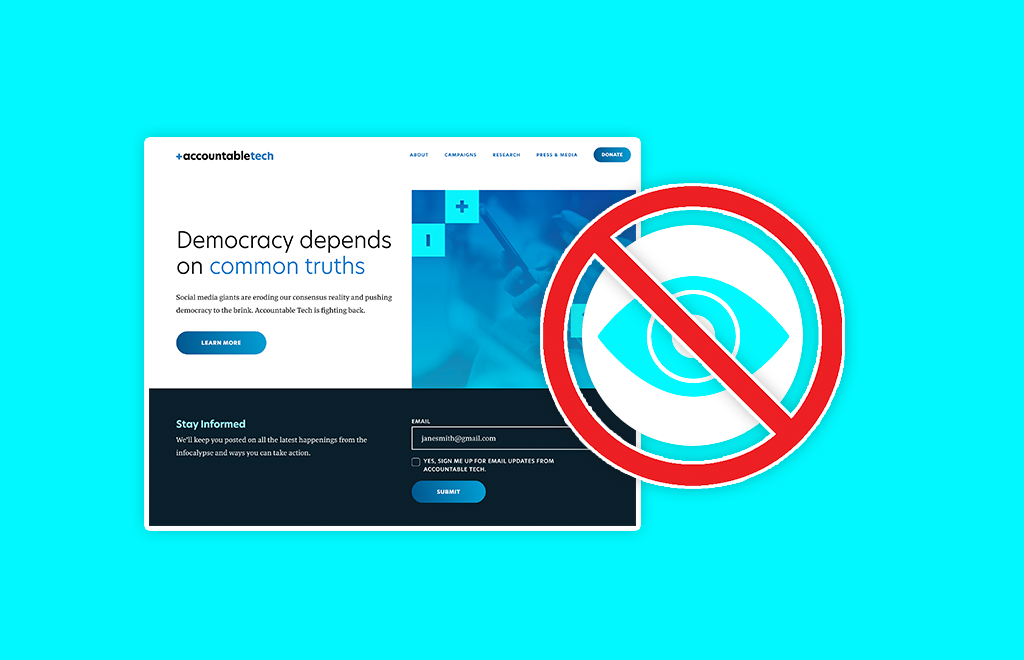When I joined Accountable Tech’s team as Digital Director last spring, one of my first priorities was to assess and improve our digital landscape. Specifically, I was charged with ensuring our website did not contribute to Big Tech’s surveillance system as we were preparing to launch a transatlantic coalition to call for a ban on surveillance advertising.
Despite my background in digital and creative issue advocacy work, this was a new undertaking for me. I had not previously prioritized building websites without Big Tech’s surveillance trackers. In fact, many nonprofit websites are “riddled with ad trackers” according to The Markup’s investigation of 23,000 nonprofit websites, which found that “86 percent of them had third-party cookies or tracking network requests.”
Most websites include cookies and ad trackers to identify, monitor, and track a visitor’s actions on the site. Cookies are small text files—strings of code—created by a web server when a visitor is on a website and stored on the visitor’s device or web browser. Cookies can serve first-party functions for a website such as allowing a pop-up lightbox only the first time a visitor comes to a website. They can also serve third-party purposes as ad trackers for other companies beyond the website’s owner, tracking a visitor’s movements on the site and online for likely advertising purposes.
Big Tech’s surveillance system is extensive and pervasive. Ad tech companies collect 72 million data points on the average child by the time they reach the age of 13, according to research by SuperAwesome. These millions of data points are collected and compiled by third-party cookies and ad trackers. It’s all part of a toxic business model of surveillance advertising. With the more ad trackers and the more time you spend online, Big Tech and ad tech companies can learn more about you and can hyper-target you with more ads. It’s a vicious cycle that incentivizes these companies to elevate emotive, polarizing, and conspiratorial content that gives rise to extremism, disinformation, and violence on and offline.
It’s a vicious cycle that incentivizes these companies to elevate emotive, polarizing, and conspiratorial content that gives rise to extremism, disinformation, and violence on and offline.
Given how many websites already have ad trackers, I want to share my learnings about how to rid a website of surveillance trackers. This information should also be helpful for those looking to build new websites without ad trackers with key considerations to keep in mind as one selects the tools and infrastructure they want for a new or existing website.

Step One: Establish the whereabouts of third-party cookies and ad trackers.
I recommend the Markup’s Blacklight tool to reveal the number of ad trackers and third-party cookies on your website as well as other Big Tech tools that feed into the toxic business model of surveillance advertising including Google Analytics. If you click the “Learn More” drop-down under the Blacklight search function, you can download an archive of the Blacklight results to further assess where these strings of code appear on your website.
Key markers of ad trackers and third-party cookies in a website’s code connect with Big Tech’s advertising tools including Google’s DoubleClick digital ad manager with code like “doubleclick,” “gstatic,” or “gtag.js.” You can work with a developer to examine the code and pinpoint what integrations are producing which ad trackers and third-party cookies. At which point, it’s helpful to create a table that outlines each of the trackers and each of the relevant integrations.

Step Two: Eliminate the integration of various tools that track cookies.
Once you have outlined which third-party cookies and ad trackers are on your website and where they are coming from in the code, you may decide to eliminate some of these integrations.
For instance, you may choose to eliminate Google Analytics entirely from your website. It’s a free tool that many websites use for analytics, but it also collects data on visitors for remarketing audiences with ads. Even Google Fonts collects some data points on visitors that can feed into Big Tech’s surveillance system. Web Open Font Format (WOFF) fonts offer an alternative by embedding fonts on a website and other analytics tools like Matomo offer a more privacy-friendly alternative for website data analytics for a small monthly price. The catchphrase: “If it’s free, you’re the product,” likely rings true in the case of integrating free tools on a website that then go on to collect data on your visitors.

Step Three: Rework some tool integrations to keep third-party cookies and ad trackers off your website.
If you deem a tool necessary for your website, you may need to work with a developer to rework that integration on your website to avoid the population of third-party cookies and ad trackers.
For instance, Accountable Tech uses EveryAction as our email CRM, but we had to rework our website’s integrations with this tool to prevent it from automatically pushing Google Analytics onto our website. Reworking integrations often requires collaborating with the help desks for various tools and working with a developer.
These three steps offer a roadmap for how to update a website without Big Tech’s surveillance trackers. Building a website from scratch without these ad trackers can also be achieved if you take into account and assess each tool you use from the start. Key questions to always ask yourself as you’re building a website: “Is this tool essential for the website?” “Does this tool feed into Big Tech’s surveillance system with third-party cookies or ad trackers?” “Do we really need this tool and can we rework it to not include these trackers for visitors?”
Together, we can take steps to curtail Big Tech’s toxic business model of surveillance advertising by eliminating third-party cookies and trackers on websites. But it shouldn’t have to be this way with the burden on nonprofits building websites for instance instead of Big Tech.
Join us at Accountable Tech in calling for a ban on surveillance advertising to stop the hyper-targeting of digital ads and slash this pervasive practice of tracking people online.








